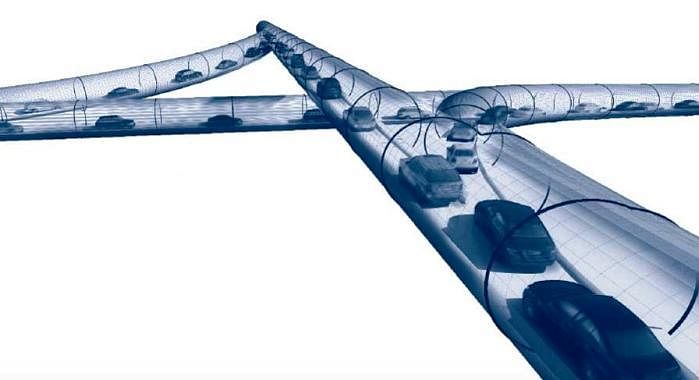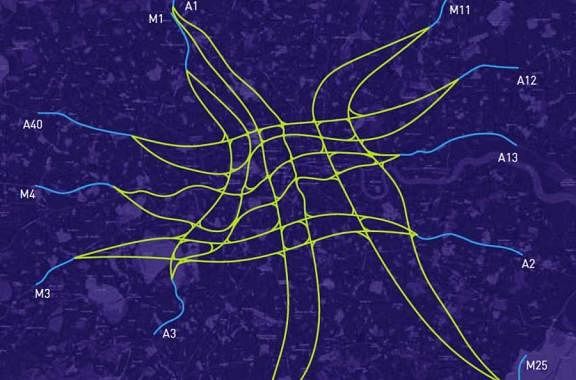Underground Cartube network the key to solve traffic congestion
Using autonomous electric cars in an underground road network could drastically reduce congestion in global cities.
A London-based architecture company has developed a traffic-beating transport solution for cities that uses autonomous electric cars in underground tunnels.
PLP Architecture’s so called Cartube, revealed today at the Institution of Mechanical Engineers in London, would use an artificial intelligence central control system to manage driverless electric vehicles. The vehicles would travel in a platoon and take passengers from door to door, meaning they’re an alternative to private cars rather than public transport.
“One of the big issues of urban transport is that in order to have a large capacity system you need segregated tracks [like a motorway], but cities are not segregated,” PLP Architecture director of research Lars Hesselgren told our sister publication, Autocar UK.
“You can’t have roads like these in places like London because of the many road intersections and traffic lights. So we did the very simple thing of calculating how many people you could move using an underground solution, and it turns out our estimate for Cartube is double what something like Crossrail can do.”

The cars would run in a platoon at speeds of around 64kph
Hesselgren’s team worked out that due to the frequency of station stops, Crossrail can only carry 18000 passengers an hour. But an underground road system that used 40mph vehicles could take 40,000 passengers in the same time.
“We’ve got 3 billion people [globally] to move into urban areas between now and 2050,” continued Hesselgren. “There is a crying need for technology that can actually solve this issue. When it comes to major cities that are already congested with a huge amount of buildings, the best solution is to put the transport underground.”
Hesselgren explained that using electric vehicles would significantly reduce ventilation issues and placing them underground would free up space on the surface previously taken up by roads. He said the artificial intelligence technology used to control the cars would need to recompute the whole system 100 times every second.
“But that is actually quite trivial because if you’re steering all of vehicles, you know in advance where they are going to be in one minute’s time, 10 minutes and so on,” he said. “It means they can constantly adjust themselves so the system can work effectively at all times.”
In short, this would eliminate the prospect of traffic jams and mean vehicles would flow smoothly from place to place. A prototype Cartube road map has been designed for London, and connects vehicles to existing motorway networks that lay outside of the city.

A prototype Cartube network has been designed for London to connect with existing motorways
But while the world’s most developed cities are often the ones most in need of a system like this, Hesselgren believes it’ll be the emerging locations that are most likely to find his idea exciting.
“Urban traffic planners [in developed cities] are still going through the same plans as they were 30 years ago,” he said. “I [therefore] suspect Britain is probably going to be quite late in the process [to consider Cartube], but a country that wants to skip a generation of technology will take it up.”
Hesselgren said that rather than building six lane motorways and essentially fast tracking themselves to the unsustainable transport scenarios of developed cities, emerging cities will want to invest in futuristic solutions like Cartube.

This Cartube prototype network for Beijing would link almost every part of the city up
“Cities are now having to compete with each other, and the first city that puts this in place and makes it work is going to be very competitive on a global scale,” he concluded.
PLP Architecture now hopes to attract a technology investor, like Google or Apple, to work with in the development of artificial intelligence software. If it secures a leading brand in the field, it believes the technology could be ready within five years.
You may like:
RELATED ARTICLES
Tata Motors: From Ice Legacy To Electric Intelligence
Tata Motors has a lot riding on the newly launched Harrier EV, coming as it does on a fresh, EV-oriented software platfo...
Complete List of Cars and SUVs Tested by Bharat NCAP
Bharat NCAP has crash-tested 20 models to date, including both ICE-powered vehicles and EVs.
Belrise Industries: A Story of Grit and Focus
The Belrise Industries IPO is the culmination of a multi-decade journey by entrepreneur Shrikant Badve that started in a...





 03 Dec 2016
03 Dec 2016
 9166 Views
9166 Views





 Ketan Thakkar
Ketan Thakkar



 Shahkar Abidi
Shahkar Abidi

